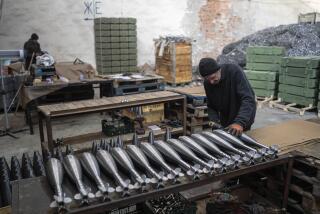Military Suppliers Feel Strain
- Share via
U.S. troops are firing so much ammunition that the military’s largest supplier of bullets can’t keep up. Tanks that log 800 miles a year in peacetime are grinding through that many miles in a month, wearing out their treads faster.
Fighting in Iraq and increased training back home are straining the military’s supplies -- and giving manufacturers in the United States a surge in business.
Dan Murphy, chief executive of bullet supplier Alliant Techsystems Inc., said the company’s Army ammunition plant in Missouri had gone through its fastest increase in production since the Vietnam War. Some production lines are running around the clock.
Alliant, based in Edina, Minn., said small-caliber ammunition was a major part of the company’s 37% increase in orders during the first quarter.
“There’s no question that on many of the items that are being consumed rapidly in Iraq, like tank treads, like body armor, like small-caliber ammunition, the Army is beginning to run out, and the Army is becoming worried about its stockpile,” said Loren Thompson, a defense analyst with the Lexington Institute in Arlington, Va.
Gen. Paul Kern, the Army’s chief logistician, has been in charge of the worrying.
He said tank tread use has been five to 10 times as high as in peacetime. Use of small-caliber bullets has more than doubled since 2001. Finding enough batteries for night-vision gear, radios and other devices has been tough.
“It’s been manageable, but it gets exciting,” Kern said of keeping the Army supplied. “Virtually all equipment in the U.S. Army is in that dynamic right now of either being used in combat or returning from combat.”
He said that combat units were in no danger of running out of ammunition and that planners had been able to shift combat-ready equipment from units outside of Iraq to supply units close to the fighting. Still, many U.S. manufacturers are working to capacity.
Saft America Inc., which makes 90% of the most common type of military batteries, has been running its plant in Valdese, N.C., around the clock for more than a year, spokeswoman Heather Moldenhauer said.
Alliant Techsystems is churning out 1.2 billion bullets a year at the Army-owned plant it runs in Independence, Mo. -- but it’s already working 24 hours a day. So the Army has given contracts for 70 million rounds each to Israel Military Industries Ltd. and the Winchester unit of Norwalk, Conn.-based Olin Corp., said Lt. Col. Matthew C. Butler, who buys bullets for all branches of the armed forces through the Army.
Butler said he was trying to line up other bullet makers, for a total of 2 billion rounds a year of capacity, in case demand surges even more.
For much of the 1990s, the military was able to rely on stockpiles amassed during the Cold War, Butler said. As recently as 2000, the Army bought about 300 million to 400 million small-caliber bullets, he said.
Analyst Thompson said politicians believed that spending on military supplies would drop once the Cold War ended.
“Policymakers convinced themselves that there would be few big fights in the near future, and many of those could be waged from the air,” he said. “Well, Iraq has proved otherwise, and as a result the Army finds itself strapped for some of the most common combat items like ammunition and armor. The Army has been under-investing in equipment for a generation.”
Alliant spokesman Bryce Hallowell said increasing production was tricky because of the tight specifications for military ammunition.
“Lives depend on that ammunition,” he said, “and you need that ammunition performing exactly the same at every turn.”
Still, Hallowell said, Alliant is looking into adding military production to a plant in Minnesota that makes hunting ammunition.
The armed forces also use bullets in training -- actually, more than is used in combat, Kern said. One reason is that supply and transportation units are getting more live-fire training now that they have become targets in Iraq.
The attack last year on a convoy of the Army’s 507th Maintenance Company, which killed nine soldiers and led to the capture of Pfc. Jessica Lynch, was one impetus for extra training for support units, Kern said.
“That wasn’t the only unit assigned to combat support to find themselves in a firefight and have to fight their way out of it,” he said.
Elsewhere, the Army is relying on suppliers to help it rebuild tank treads that are wearing out in Iraq and Afghanistan.
The rebuilding and manufacturing facility at the Red River Army Depot in Texarkana, Texas, has been running seven days a week, three shifts a day.
“It’s hard, dirty, hot work,” Kern said, referring to a process in which the rubber has to be stripped off the metal track and new rubber put on.
The Red River depot has added employees to make and refurbish tank tracks and to overhaul engines for Bradley fighting vehicles and two other vehicles, said Felix H. McLellan, deputy to the commander of the Army-run plant.
“We’re doing quite well,” Kern said, “but the demand is so heavy it’s stressing not only our capability but it’s stressing our suppliers.”
More to Read
Inside the business of entertainment
The Wide Shot brings you news, analysis and insights on everything from streaming wars to production — and what it all means for the future.
You may occasionally receive promotional content from the Los Angeles Times.










